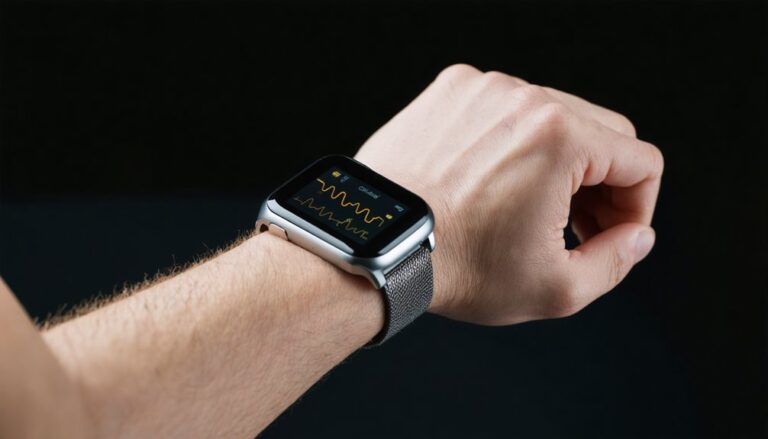Wearable health technology has become a crucial tool for achieving wellness. These devices feature advanced sensors that track vital signs such as heart rate, blood pressure, and sleep patterns in real-time. By monitoring physiological metrics, individuals can take proactive steps to manage their fitness and well-being. Personalized observations and alerts enable users to make informed decisions about their health. Real-time monitoring is key to this approach, allowing individuals to respond promptly to changes in their physical condition. Effective health management relies on accurate and timely data, which wearable health tech provides.
Highlights
Real-Time Wellness Tracking with Wearable Health Tech
Wearable health devices use sensors to monitor key health metrics, including physical activity, sleep patterns, and cardiovascular health. This real-time data allows for swift action in response to health anomalies, empowering users to set and achieve realistic health goals. With personalized recommendations and alerts, individuals can stay motivated and informed about their health metrics, taking control of their overall well-being.
Advanced algorithms analyze captured data to ensure accuracy, presenting results via companion apps or web platforms. This promotes preventive care and encourages active engagement with health. By continuously monitoring vital signs, such as heart rate and rhythm, wearable health tech simplifies proactive health management.
Taking Control of Your Health
With wearable health devices, individuals can monitor their health metrics in real-time, making informed decisions about their lifestyle and habits. This technology provides a comprehensive picture of one’s health, enabling users to identify areas for improvement and track progress over time. By leveraging wearable health tech, individuals can take a proactive approach to their health, reducing the risk of chronic diseases and improving overall wellness.
The Power of Data-Driven Insights
Wearable health devices provide valuable insights into an individual’s health, enabling them to make data-driven decisions about their lifestyle and habits. By analyzing captured data, users can identify patterns and trends, making informed choices about their diet, exercise, and sleep habits. This data-driven approach to health empowers individuals to take control of their well-being, making positive changes that can have a lasting impact on their overall health.
As Dr. David Katz, a leading expert in preventive medicine, notes, “The power of wearable health tech lies in its ability to provide individuals with actionable insights into their health, empowering them to make informed decisions about their lifestyle and habits.” By harnessing the power of wearable health tech, individuals can take a proactive approach to their health, improving their overall well-being and reducing the risk of chronic diseases.
How Wearable Health Tech Works
The Inner Workings of Wearable Health Tech
Wearable health devices have become increasingly popular, and understanding how they work is vital for those looking to monitor their health. These devices use sensor technology to track essential health metrics, providing users with a comprehensive view of their well-being. A combination of accelerometers, gyroscopes, and heart rate monitors is typically used to capture data on physical activity, sleep patterns, and cardiovascular health.
This data is then analyzed using advanced algorithms to ensure accuracy. The results are presented to the user through a companion app or web platform, allowing them to make informed decisions about their health and wellness. Advanced sensor technology and a focus on data accuracy have transformed the way we approach health monitoring.
For instance, wearable devices like fitness trackers and smartwatches can track daily activity, sleep quality, and heart rate, providing valuable insights into overall health. By analyzing this data, users can identify areas for improvement and make changes to their lifestyle to achieve better health outcomes.
The Impact of Wearable Health Tech
The use of wearable health devices has significant implications for public health. By empowering individuals to take control of their health, these devices can help reduce the burden on healthcare systems.
Moreover, wearable devices can provide valuable insights into population health trends, enabling healthcare professionals to develop targeted interventions and improve health outcomes.
As the technology continues to evolve, we can expect to see even more innovative applications of wearable health devices. For example, wearable devices that track blood glucose levels or detect irregular heart rhythms are already being developed. These advancements have the potential to revolutionize the way we manage chronic conditions and respond to medical emergencies.
A New Era in Health Monitoring
Wearable health devices have marked a significant shift in the way we approach health monitoring. By providing individuals with real-time data and insights, these devices have empowered people to take control of their health.
As the technology continues to advance, we can expect to see even more innovative applications of wearable health devices, leading to better health outcomes and improved quality of life.
Benefits of Using Wearable Health Devices
Unlocking Better Health with Wearable Devices
Incorporating wearable health devices into your daily routine can have a significant impact on your overall well-being. By tracking vital signs, physical activity, and other key health metrics, you can gain a deeper understanding of your body and make informed lifestyle changes.
For example, wearable devices can help you monitor your progress over time, set achievable goals, and celebrate milestones. Many devices also offer personalized recommendations and alerts, keeping you motivated and on track. By using wearable technology, you can take a proactive approach to managing your health, reducing the risk of chronic diseases, and improving your quality of life.
One of the key benefits of wearable devices is the ability to track your physical activity. By monitoring your daily exercise and movement, you can identify areas for improvement and make adjustments to your routine. This can include setting realistic goals, such as increasing your daily step count or completing a certain number of workouts per week.
Another advantage of wearable devices is the ability to monitor your sleep patterns. By tracking your sleep duration, quality, and stages, you can identify potential issues and make changes to improve your sleep hygiene. This can include establishing a consistent bedtime routine, avoiding caffeine and electronics before bedtime, and creating a relaxing sleep environment.
Using Data to Inform Lifestyle Changes
Accurate health data is essential for making informed decisions about your lifestyle. By tracking your health metrics over time, you can identify patterns and trends that can inform healthy choices. For example, if you notice that your blood pressure is consistently high, you can take steps to reduce your sodium intake, increase your physical activity, and manage stress.
A Personalized Approach to Health
Many wearable devices offer personalized recommendations and alerts, helping you stay on track and motivated. By using a wearable device, you can receive tailored advice and guidance on how to improve your health, based on your unique needs and goals.
“Wearable devices have revolutionized the way we approach health and wellness. By providing accurate and personalized data, individuals can take a proactive approach to managing their health and reducing the risk of chronic diseases.” – Health Expert
Taking Control of Your Health
By incorporating wearable technology into your daily routine, you can take a proactive approach to managing your health. By tracking your health metrics, setting realistic goals, and celebrating milestones, you can improve your overall well-being and reduce the risk of chronic diseases.
With the right wearable device, you can unlock better health and start living your best life.
Choosing the Right Wearable Health Tech for Your Needs
Finding the Right Wearable Health Tech for Your Needs
With so many wearable health tech options available, selecting the best device for your needs can be a challenge. To make an informed decision, it’s crucial to compare features across different devices. Research and analyze the various features offered, such as heart rate monitoring, sleep tracking, and GPS capabilities. This will help you understand which device aligns with your specific requirements.
In addition to feature comparisons, reading user reviews can provide valuable insights into a device’s performance, comfort, and user interface. Look for reviews from individuals with similar needs and preferences to gauge the device’s effectiveness. This will give you a better understanding of how the device works in real-life scenarios.
By considering both feature comparisons and user reviews, you can confidently select a wearable health tech device that meets your needs and improves your overall well-being.
A well-chosen device can make a significant difference in your daily life, allowing you to track your progress, set goals, and make informed decisions about your health.
“Investing in a wearable health tech device is not just about tracking your fitness goals; it’s about taking control of your health and well-being.”
Monitoring Your Vital Signs With Wearable Health Tech
Taking Control of Your Health with Wearable Tech
Monitoring vital signs is crucial for maintaining good health. Wearable health tech devices have simplified tracking this information, enabling users to take proactive steps towards wellness. These devices continuously monitor heart rate and rhythm, alerting users to unusual patterns or abnormalities. Many wearables also track blood pressure, providing valuable insights into cardiovascular health.
Some devices track additional vital signs, such as oxygen saturation and body temperature. By monitoring this essential data, individuals can identify potential health issues early, facilitating prompt medical attention and preventing more serious conditions from developing. Wearable health tech empowers users to prioritize their health, fostering a sense of well-being and community.
With wearable devices, users can track their vital signs in real-time, allowing for swift action when anomalies are detected. For instance, if a user’s heart rate or blood pressure exceeds normal ranges, they can seek medical attention immediately. This prompt response can significantly reduce the risk of developing chronic conditions, such as heart disease or diabetes.
By incorporating wearable health tech into daily life, individuals can experience the benefits of preventive care. These devices encourage users to engage actively with their health, promoting a culture of wellness and self-care.
As the wearable health tech market continues to evolve, users can expect even more innovative features and capabilities to emerge, further empowering them to take control of their health.
“The key to a healthy life is knowledge. Wearable health tech devices provide users with the data they need to make informed decisions about their well-being.”
The Future of Wearable Health Tech: Trends and Innovations
Advancements in Wearable Health Tech: A New Era of Personalized Health Management
The wearable health tech industry is witnessing a significant transformation, driven by innovations that are changing how individuals manage their health. Smart fabrics, a recent development, can monitor vital signs, detect anomalies, and provide personalized feedback.
Integration of artificial intelligence enables wearables to analyze user data and provide more accurate insights. Sensor technology advancements allow for more precise tracking of health metrics, such as heart rate and blood pressure.
These innovations mark a new era in wearable health tech, enabling individuals to take a proactive approach to their health and wellbeing. With the ability to track vital signs and receive personalized feedback, individuals can make informed decisions about their health.
As the industry continues to evolve, we can expect to see even more innovative solutions that cater to the diverse needs of individuals. The future of wearable health tech holds promise for empowering individuals to take control of their health and wellbeing.
“The convergence of wearable technology, AI, and data analytics will revolutionize the way we approach healthcare, enabling individuals to make informed decisions about their health and wellbeing,” says a leading expert in the field.
In the coming years, we can expect to see significant advancements in wearable health tech, including improved accuracy, enhanced user experience, and more personalized solutions.
As the industry continues to grow, individuals will have access to a wide range of innovative solutions designed to improve their health and wellbeing.
Integrating Wearable Health Tech Into Your Daily Routine
Integrating Wearable Health Tech into Daily Life
Wearable health tech plays a significant role in daily life by integrating into daily habits, providing users with a better understanding of their well-being. By using these devices, individuals can track their progress, set achievable goals, and make informed decisions about their health.
For instance, incorporating wearable health tech into daily routines allows users to monitor their physical activity, sleep patterns, and nutrition. This leads to improved overall wellness as users become more aware of their health metrics. With this increased awareness, individuals can take proactive steps to maintain a healthy lifestyle.
Moreover, wearable health tech enables individuals to take control of their well-being, fostering a sense of responsibility and motivation to prioritize their health. A study found that individuals using wearable devices are more likely to engage in physical activity and make healthier choices. By having a holistic view of their health, individuals can make data-driven decisions and develop healthier habits.
Monitoring Daily Progress
By tracking daily progress, individuals can set and achieve realistic goals. Wearable health tech provides users with accurate and comprehensive data, helping them stay on track and make necessary adjustments. This real-time feedback loop empowers individuals to take a proactive approach to their health, making informed decisions that impact their overall wellness.
Staying Motivated
One of the benefits of wearable health tech is its ability to motivate individuals to maintain a healthy lifestyle. By monitoring progress and setting achievable goals, individuals can celebrate their successes and identify areas for improvement. This constant motivation encourages individuals to prioritize their health, leading to long-term benefits.
“Wearable technology allows us to take control of our health and wellness by providing us with a holistic view of our daily habits and progress.”
Conclusion
Wearable health technology has changed the way people monitor and manage their health. These devices provide real-time data, enabling users to make informed decisions about their well-being. As technology advances, wearables are becoming a normal part of daily life, allowing individuals to optimize their fitness and overall health.
With the ability to track vital signs, physical activity, and sleep patterns, wearables offer a personalized understanding of one’s health. This information can be used to set realistic goals and make sustainable lifestyle changes. By integrating wearables into daily routines, individuals can take control of their health and make data-driven decisions to improve their well-being.
The impact of wearable health technology extends beyond individual benefits. By promoting healthy habits and early intervention, wearables can contribute to a healthier population. As the technology continues to evolve, it is likely that wearables will play a significant role in shaping the future of healthcare.
“Technology is not a substitute for human connection, but it can be a powerful tool for improving our health and well-being.”




